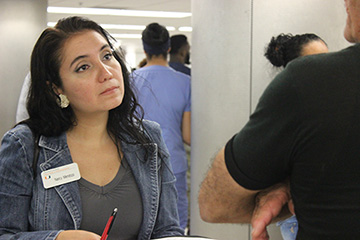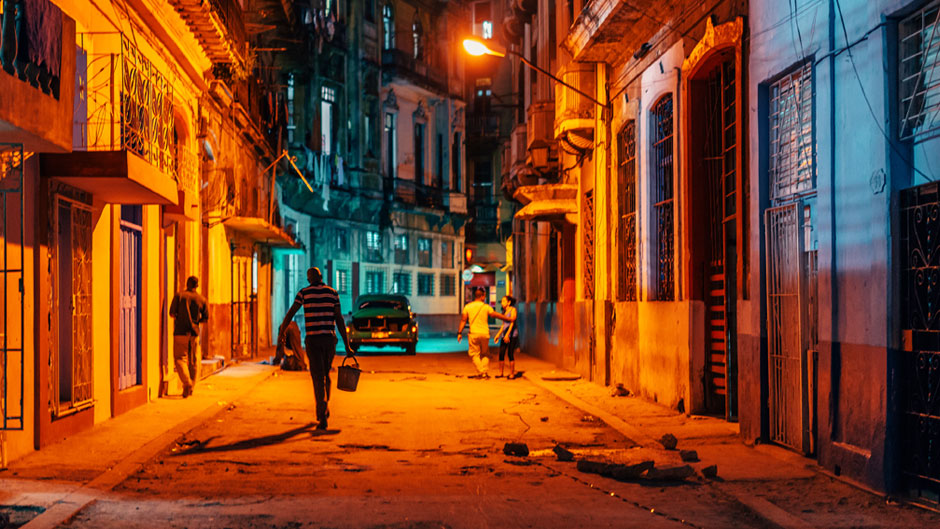When Evaristo lived in his native Cuba, hardly a day went by where he wasn’t dealing with water-related problems such as contaminated drinking water, leaky pipes or streets flooded with raw sewage.
The 60-year-old emigrated to the United States two years ago, leaving those problems behind. But when he returned to Cuba recently to visit his daughter in Havana, he discovered matters hadn’t improved but worsened—he still had to drink bottled water, shower late at night when the water pressure was sufficient, and avoid swimming in dirty rivers and streams.
“Everything in the island needs refurbishing,” he told University of Miami student Nancy Mendoza while waiting for a friend at Miami International Airport (MIA). “Water is no different.”
His story is a recurring one for Mendoza, a Miami Law student who for the past year has been conducting surveys of newly arriving travelers from Cuba to document the water problems on the Communist island.
Her work is part of an interdisciplinary study by College of Engineering Professor Helena Solo-Gabriele, School of Communication Professor Joseph B. Treaster and Catholic University of America sociologist Enrique Pumar to determine the state of the water in Cuba.
“The information we have on Cuban water is old and the data that is available is not peer-reviewed,” said Solo-Gabriele, who is of Cuban descent but has not visited the island. “We wanted to know the state of the water on the island.”
Initially funded by the UM Center for International Business Education and Research (CIBER) and the Center for Communication, Culture and Change at the School of Communication, the study hopes to quantify the availability of water, its quality and the impact it may have on people’s health, said Solo-Gabriele.
 |
| Nancy Mendoza, a Miami Law L.L.M. student from Venezuela, interviews a Cuban resident in Miami as he waits for family to arrive from Havana at the Miami International Airport. |
So far Mendoza and other UM students participating in the study have logged 500 interviews through a 43-question questionnaire. They hope to finish 100 more for the study to be completed. The interviews are taking place at Miami International Airport so as to avoid the restrictions Cuba would impose on external scrutiny of the country’s infrastructure, said the scholars.
Cuba water issues stem from an obsolete and deteriorating infrastructure. The original water and sewage systems on the island were installed prior to the Cuban Revolution in 1959. Very little maintenance has been done on the system in the five decades since, said Solo-Gabriele.
Daily water shortages, leaky pipes, non-working toilets and contaminated water is common. This may surprise many people, especially tourists who are visiting the island by the thousands since renewed relations between the U.S. and Cuba were established in 2014, said Treaster, who has worked on other water-related projects and visited Cuba many times in the ‘80s and '90s as a reporter for the New York Times.
“First thing I thought was Cuba has a great reputation for public health, what water problems could there be,” said Treaster, but then he remembered that as a visiting journalist he only drank bottled water.
Tourists who visit the island encounter a very different reality with water issues. Hot baths and potable water is available around the clock for those who visit Cuba and stay at hotels, said Solo-Gabriele. But for every day citizens the reality of dealing with water issues can be daunting.
A large part of the problem in Havana stems from the aquifer underneath the Almendares River, said Solo-Gabriele. “The river is receiving all of the sewage and river water infiltrates into the aquifer, putting the drinking water at risk.”
Among the initial findings of the study:
- Water scarcity affects Cuban citizens almost daily.
- The outdated pipes are so corroded that often the water is contaminated.
- Most Cubans have cisterns or water tanks in their yards to store water because official water systems usually provide running water for a few hours a day.
- Water pressure is an issue in many buildings, requiring residents to use buckets to bathe themselves.
- Disposal of garbage is spotty. Often, the trash ends up in the water, causing health problems.
Pumar, who was born in Cuba, and has visited the island in the ‘70s and '80s, said that he was surprised by the extent of the water problems, noting that their interviews of newly arrived visitors cover folks who have come from several cities on the island.
“We have even heard of people getting sick from bottled water that they bought on the black market,” he said. “One journalist got sick because he ordered ice in a restaurant.”
Often, water bottles sold on street are filled with tap water and sometimes ice cubes are made with purified water, but they become contaminated by bartenders and waiters who failed to wash their hands after using the bathroom, said Treaster.
The scholars have an invitation to present at the Miami Institute for Advanced Study of the Americas at UM in the spring. Their study will be published in the journal Cuba in Transition, and they will write an article on the study for the journal Cuban Affairs.
Pumar said the scholars presented their findings at the July 2016 conference of the Study of the Cuban Economy in Miami.
They plan to launch a website with all the data to help organizations and businesses interested in investing in the island to become acquainted with the challenges.
On the practical side, the researchers want the website to be useful to the Cubans on the island and Cuban-Americans who visit their families and friends. Pumar believes that a push to educate both populations with tips such as how they should boil water and store it and the use of water filters would be very beneficial.

